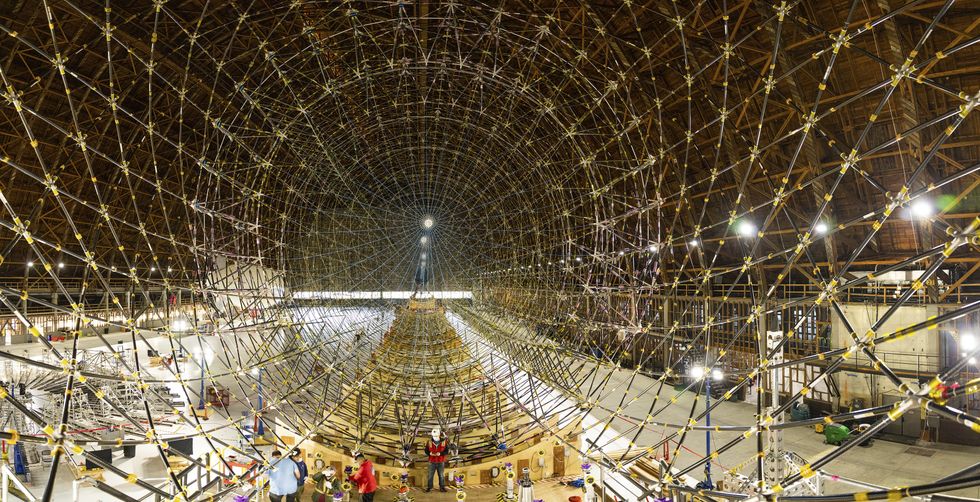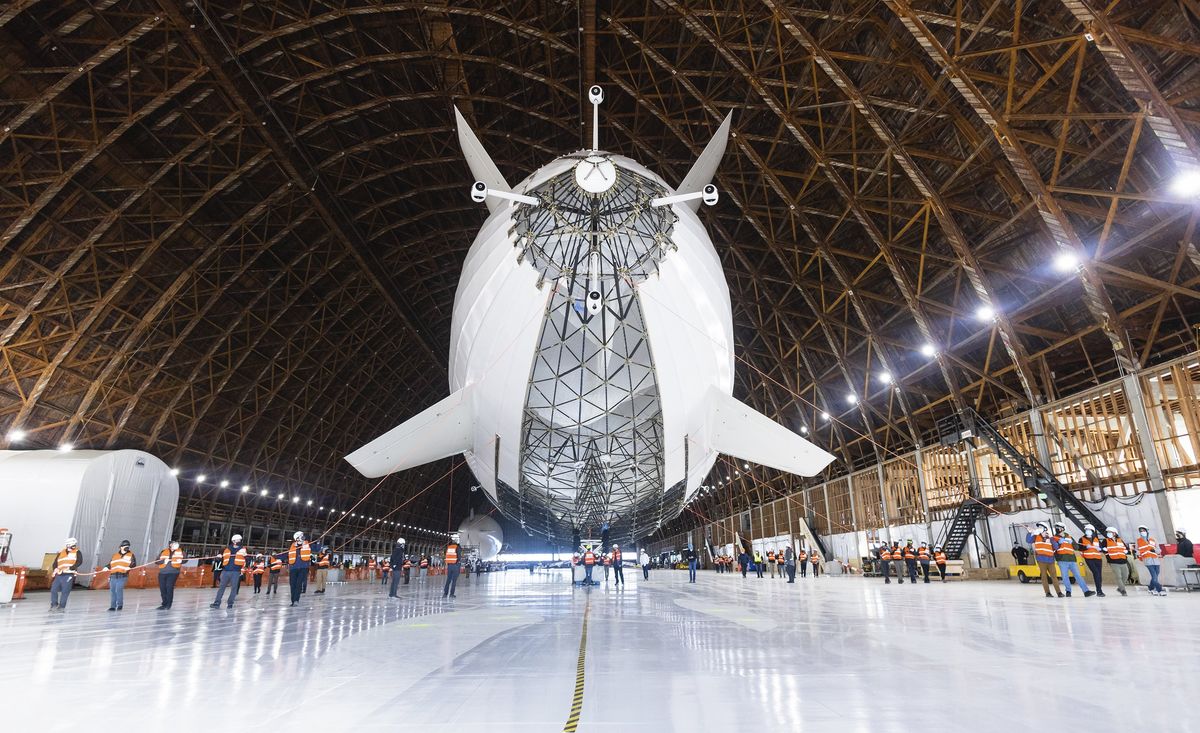Expect traffic on the 101 highway in Mountain View, Calif., to be even worse in the days or weeks ahead, as motorists slow down to watch Google cofounder Sergey Brin’s 124-meter-long airship, Pathfinder 1, launch into the air for the first time.
IEEE Spectrum has learned that LTA Research, the company that Brin founded in 2015 to develop airships for humanitarian and cargo transport, received a special airworthiness certificate for the helium-filled airship in early September.
That piece of paper allows the largest aircraft since the ill-fated Hindenburg to begin flight tests at Moffett Field, a joint civil-military airport in Silicon Valley, with immediate effect.
The certificate permits LTA to fly Pathfinder 1 within the boundaries of Moffett Field and neighboring Palo Alto airport’s airspaces, at a height of up to 460 meters (1,500 feet). That will let it venture out over the southern part of San Francisco Bay, without interfering with planes flying into or out of San Jose and San Francisco International commercial airports.
In a letter supporting its application for the certificate, LTA wrote: “Pathfinder 1’s experimental flight test program is to demonstrate and establish the flight envelope for the airship…. LTA’s test plan is tailored to include substantial indoor and outdoor ground testing, using a build-up approach to gradually increase the flight envelope.”
The huge airship will initially be attached to a mobile mast for outdoor ground testing, before conducting about 25 low-level flights, for a total of 50 hours’ flight time.
Although its rigid design hearkens back to the gargantuan airships of the early 20th century, Pathfinder 1 is almost completely different from any large airship that has flown before. Crucially, its reported 3,000 welded titanium hubs and 10,000 carbon-fiber-reinforced polymer tubes are light enough that it can use nonflammable helium instead of explosive hydrogen as a lifting gas.

Twelve electric motors distributed on the sides and tail of the airship, and four fin rudders, allow for vertical takeoff and landing (VTOL) and speeds of up to about 120 kilometers per hour. A tough layer of laminated Tedlar material contains 13 helium bags of ripstop nylon, which contain lidar systems to track the gas levels within.
Pathfinder 1 has a hybrid propulsion system, with two 150-kilowatt diesel generators working alongside 24 batteries to provide power for the electric motors, according to a recent presentation by LTA’s CEO, Alan Weston. He said that LTA has plans to use hydrogen in later versions of the airship, perhaps as fuel for future fuel cells or turbogenerators, and possibly even as a lifting gas.
LTA confirmed the airworthiness certificate had been granted but did not provide any further details.
Although the Pathfinder 1 is designed for single-pilot operation, it has dual controls and, according to LTA’s letter to the FAA, will have a second pilot on board “for initial flight testing until pilot workload can be assessed.” The gondola that LTA is using for the airship was designed by the famous Zeppelin company in Germany and can accommodate up to 14 people, although no superfluous passengers will be allowed during testing.
After extensive flight-testing in California, the Pathfinder 1 will transit to the former Goodyear Airdock airship hangar in Akron, Ohio, which the company has acquired as its future manufacturing location. An even larger, 180-meter-long airship, the Pathfinder 3, is already under development.
Ultimately, LTA intends its aircraft to be used for humanitarian missions, deploying cargo and personnel to areas that are inaccessible by road. Brin funds a separate nonprofit, called Global Support and Development, that has already carried out such missions by sea, in the Caribbean, Latin America, and South Pacific. Brin formed GSD after using his own yacht to ferry medical personnel to the scene of a cyclone in the South Pacific. The non-profit has since used other vessels, in partnership with the nonprofit Yacht Aid Global, to respond to hurricanes and other disasters. GSD also recently launched a purpose-built vessel capable of transporting dozens of medical staff and full-size shipping containers. The MV Dawn also carries its own watercraft and vehicles, and is capable of producing and off-loading bulk supplies of fresh water, and could be a model for future humanitarian airships.
Pathfinder 1’s airworthiness certificate is valid for a full year, although LTA told the FAA in its application letter that it expects the test program to be complete within 180 days.
This article appears in the January 2024 print issue as “World’s Biggest Aircraft Clears for Flight.”
Update 30 Oct. 2023: This story was updated to correct engineering details on the Pathfinder 1 (3,000 titanium hubs, not the 96 originally reported; 10,000 carbon fiber tubes, not the 288 originally reported) as well as to clarify Sergey Brin’s specific role in relation to Global Support and Development.
Mark Harris is an investigative science and technology reporter based in Seattle, with a particular interest in robotics, transportation, green technologies, and medical devices. He’s on Twitter at @meharris and email at mark(at)meharris(dot)com. Email or DM for Signal number for sensitive/encrypted messaging.



